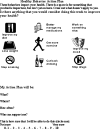Linking a motivational interviewing curriculum to the chronic care model
- PMID: 20737238
- PMCID: PMC2940440
- DOI: 10.1007/s11606-010-1426-6
Linking a motivational interviewing curriculum to the chronic care model
Abstract
Background: Unhealthy lifestyle choices frequently cause or worsen chronic diseases. Many internal medicine residents are inadequately trained to provide effective health behavior counseling, in part, due to prioritization of acute care in the traditional model of medical education and to other systemic barriers to teaching psychosocial aspects of patient care.
Aim: To address this gap in training, we developed and piloted a curriculum for a Primary Care Internal Medicine residency program that links a practical form of motivational interviewing (MI) training to the self-management support (SMS) component of the chronic care model.
Participants and setting: All 30 primary care residents at Alameda County Medical Center were trained in the curriculum since it was initiated in 2007 during the California Academic Chronic Care Collaborative.
Program description: Residents participated in three modules during which the chronic care model was introduced and motivational interviewing skills were linked to the model's self-management support component. This training was then reinforced in the clinical setting. Case-based interactive instruction, teaching videotapes, group role-plays, faculty demonstration, and observation of resident-patient interactions in the clinical setting were used to teach the curriculum. PROGRAM ASSESSMENT: A preliminary, qualitative assessment of this curriculum was done from a program standpoint and from the perspective of the learners. Residents reported increased sense of confidence when approaching patients about health behavior change. Faculty directly observed residents during clinical encounters using MI and SMS skills to work more collaboratively with patients and to improve patient readiness for self-management goal setting.
Conclusion: A curriculum that links motivational interviewing skills to the chronic care model's self-management support component and is reinforced in the clinical setting is feasible to develop and implement. This curriculum may improve residents' confidence with health behavior counseling and with preparing patients to become active participants in management of their chronic conditions.
Figures



References
Publication types
MeSH terms
LinkOut - more resources
Full Text Sources
Miscellaneous

